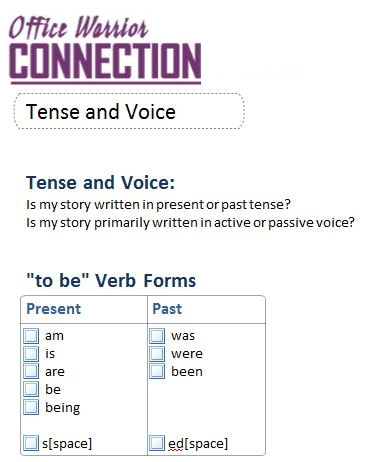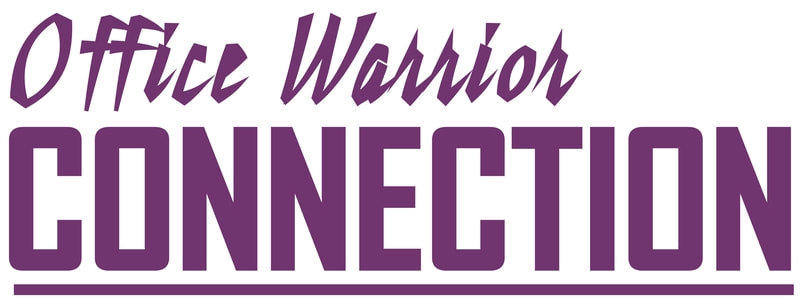|
5/27/2019 Day 27 - Voice and Tense Voice (whether active or passive) is sometime confused with tense. I think it might be because of the overlap in the usage of helping verbs, such as the eight forms of "to be" (am, is, are, was, were, be, being, been). I'm going to cover both here so you can look through your novel and make sure you are being consistent in both tense and voice. Past vs Present vs Future Verb Tense Verb tense places the verb someplace in time. The verb reflects an action that happened in the past, is happening right now, or will happen in the future. As important as it is to use the correct active or passive tense, It's also important to be consistent with verb tense. While dialog may be written to project into the future, the narrative of a story tends to be written in active or past verb tense. Therefore, I will not focus on future verb tense as part of this discussion. Present verb tense means the actions of the characters are happening in real time as if a news reporter or sports caster were giving a play-by-play. Officer Bob looks around. He steps to the counter. "I will have a jelly," he says. Past verb tense, on the other hand, is when the action has already happened. In this case, it is the historian reporting what happened just a moment ago or even many years ago. Officer Bob glanced around again. He leaned in to the counter. "I will have a cream filled, too," he said. Note that present tense verbs often end is "s" while past tense verbs end in "ed." Therefore, this can be a good visual cue when confirming tense is staying consistent throughout a story. In terms of writing a story, neither form of verb tense is necessarily right or wrong. It is a matter of choice whether a story is written in past or present tense. However, it is important that consistency be maintained. Combining the two examples above into one paragraph would be grammatically incorrect because the tense would not be consistent. The reader can be confused about when things are happening. It's important to note that tense does not determine absolute time in a narrative unless both tenses are used within the same narrative. So, while you should maintain tense in a consistent manner, there is a very good reason to use both past and present tense throughout a story. A good time to change verb tense would be when you are describing events that happen in two different times. For instance, you may be writing in first person present tense with a narrator telling the story, but need him to talk about something that happened in the past. I look around and think about when I ate the donuts from the corner shop. "Look" and "think" are present tense while "ate" is past tense. In this case, mixing tense may be appropriate because the actions are happening at different times. I say "may" because there is not enough text surrounding this one sentence to provide exact context. Presumably, the first person narrator is speaking in current tense throughout the rest of the story, but ate donuts at some earlier point in time. What's that got to do with Helping Verbs? Helping verbs can also be affected by tense, but current writing trends are in favor of eliminating them. The trend is to use a stronger or more direct verb rather the helping verb. For example, consider the following sentence: The bird was flying. In this case, the sentence can be simplified with a more direct verb showing the action as a fact. In other words: The bird flew. You may have noticed that these are relatively easy to spot because they are often paired with "-ing" words. In some cases, you may not want to eliminate the helping verb. My rule of thumb is to read it aloud and see how it sounds. For instance, I prefer "It is raining outside" as opposed to "It rains outside" simply because the first sounds better to my ear. Active vs Passive Voice To complicate things a little more, let's take a look at active and passive voice which have to do with when a verb shows up in a sentence. A sentence is in active voice when the subject of the sentence is performing the action. In this case, the verb follows the subject. The chef decorated the wedding cake. A sentence is in passive voice when the subject is being acted upon. In this case, the verb shows up in the sentence before the subject. The other key word often found in passive voice is "by" as demonstrated below. The wedding cake was decorated by the chef. The key to understanding whether a sentence is in active or passive voice is figuring out the action (verb), then looking at what is performing that action. In both sentences, it was the chef doing the decorating, but in the second sentence, even though he is the doing the decorating, he is not the subject. The reason I think active and passive tense is further complicated is because of the "to be" verbs. In the section above, "was" was a helping verb attached to an "-ing" word, but here it appears to be tied to an "-ed" word. However, when you put the sentence in active voice and leave the "to be" verb, it gets fixed in the following manner: The chef was decorating the wedding cake. Note that all of the sentences are grammatically correct. So why worry about active or passive voice at all? One reason is because active voice is easier to understand. The sentences above are very simple examples. In a more complex sentence, passive voice can be tricky to unravel. Sometimes the "actor" is omitted completely from the sentence and that can be even more confusing. Consider the following: Rules are made to be broken. Who is the actor in this sentence? That's a trick question. The actor has been omitted and without more context around the sentence, the reader would have no way of determining if the actor was me, you, or them. If the actor was put on the end of that sentence, though, it would need to be proceeded with "by." Current trends in writing push to write in active voice, but that doesn't mean there aren't some instances where passive can be an effective form of writing. You might use passive voice when the subject is irrelevant or unknown or when you intentionally want to be vague or talk generalizations. In other words, the rules are made to be broken by anyone who understands the rules. Exercise: Review and Correct Tense and Voice
Parameters
DOWNLOAD: Tense and Voice Worksheet Template Instructions Return to the Table of Contents Go to Day 28 - Crutch and Filter Words Comments are closed.
|

 RSS Feed
RSS Feed
